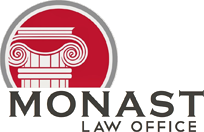
Do you experience sharp, shooting pain radiating from your lower back down your legs? Does this discomfort make standing, walking, or performing your regular work duties challenging? If you have already been diagnosed with lumbar radiculopathy, you are likely wondering whether you have a basis for receiving workers’ compensation. The crucial factor is demonstrating that your condition resulted from your job activities or was aggravated by them.
At Monast Law Office in Columbus, we partner with a lot of people in physically demanding occupations. Our team can help you understand workers' compensation options for lumbar radiculopathy and fight for the benefits you deserve. Here are detailed answers to help you understand your rights and options.
What Exactly Is Lumbar Radiculopathy?
This condition occurs when nerve roots in your lower back—the lumbar region—become compressed or irritated. Think of your spinal nerves like branches growing from your spinal cord: when one gets pinched or squeezed, it can cause pain, numbness, tingling, and weakness that travels along that nerve's path. The symptoms often radiate from your lower back into your buttocks, legs, and feet—which frequently manifests into another condition, sciatica.
Which Professionals Are Most at Risk for Developing This Condition?
While anyone can develop lumbar radiculopathy, certain occupations face higher risks:
- Construction workers and warehouse employees who regularly lift heavy materials or work in awkward positions.
- Healthcare workers, especially nurses and nursing assistants, who transfer and position patients throughout their shifts.
- Factory workers performing repetitive motions on assembly lines or maintaining fixed postures.
- Truckers, delivery drivers, and heavy equipment operators exposed to constant vibration and who sit for long periods.
- Even office workers can develop symptoms from prolonged sitting with poor posture or inadequate ergonomic support.
How Do I Know if My Lumbar Radiculopathy Is Work-Related?
In our experience, several workplace factors commonly contribute to this condition:
- If your job requires frequent bending, twisting, or heavy lifting, these actions can gradually damage spinal discs and compress nerves.
- Maintaining awkward positions or sitting for extended periods without proper support strains your lower back.
- Operating vibrating equipment or vehicles can accelerate wear and tear on spinal structures.
- If symptoms worsen during work activities or improve during time off, this suggests a workplace connection.
What Benefits Can I Receive Through Workers' Compensation?
Since no two people are alike, no two cases are the same, either. It’s also important to note that the Ohio Bureau of Workers’ Compensation (BWC) doesn’t have a set formula for determining an amount of compensation for lumbar radiculopathy.
But at Monast Law Office, we can help you pursue benefits based on the severity of your condition. This includes:
- Medical treatment coverage, such as doctor visits, physical therapy, medications, potential surgery, and rehabilitation.
- Temporary total disability compensation while you can’t work during recovery.
- Permanent partial disability benefits if you have a lasting impairment.
- Vocational rehabilitation if you need help returning to work or finding a new occupation.
What Evidence Do I Need for a Successful Claim?
Great question! Let’s just say all of it! But more specifically:
- Detailed medical records documenting your diagnosis, symptoms, treatment plan, and ongoing rehabilitation. Your medical records should show a clear progression of your condition and how treatments have affected your symptoms.
- A comprehensive evaluation from a spine specialist who can explain the severity of your nerve compression and its relationship to your work duties. This specialist should document diagnostic tests like MRIs or nerve conduction studies confirming a lumbar radiculopathy diagnosis.
- Documentation from your health care providers linking your condition to specific work activities. Your doctors should outline how particular job tasks contributed to or worsened your lumbar radiculopathy.
- Records of any physical restrictions and how they affect your job duties. These should include specific lifting, bending, twisting, sitting, or standing limitations.
- A detailed work history showing when symptoms began and how they progressed. Include records of any workplace incident reports or early complaints of back pain.
- Documentation of failed attempts to work with restrictions or modified duties, if applicable. This demonstrates the severity of your condition and its impact on your ability to work.
- Statements from coworkers or supervisors who have witnessed your struggles with work tasks due to your symptoms. These accounts establish the work-related nature of your condition.
- A daily symptoms log and how they affect both work and personal activities to show the full impact of your injury on your quality of life.
- Records of any ergonomic assessments or workplace safety evaluations that identify risk factors for spinal conditions in your job duties. These reports strengthen the task-related connection.
When Should I Contact Monast Law Office?
If you have questions about filing a lumbar radiculopathy claim, first, download our free ebook, The Worker’s Guide to Injury Compensation in Ohio. Then, contact our office for a complimentary consultation regarding any number of topics, such as:
- Why your claim has been denied despite clear evidence linking your condition to work.
- You're receiving pressure to return to work before you've healed properly.
- The BWC disputes the work-related nature of your condition.
- You need help documenting the full impact of your injury on your earning capacity.
Our Columbus legal team will be happy to help you understand your rights and the next steps in your case.

